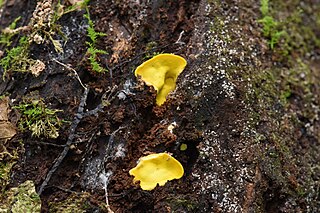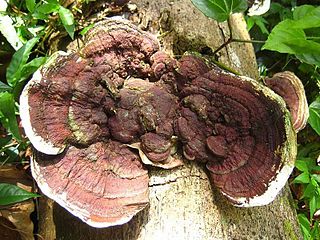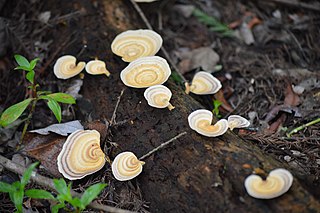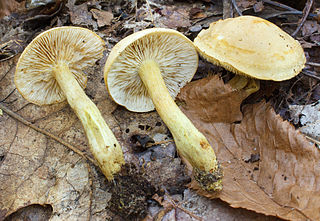
The Polyporaceae are a family of poroid fungi belonging to the Basidiomycota. The flesh of their fruit bodies varies from soft to very tough. Most members of this family have their hymenium in vertical pores on the underside of the caps, but some of them have gills or gill-like structures. Many species are brackets, but others have a definite stipe – for example, Polyporus badius.

Hymenochaete is a genus of fungi in the family Hymenochaetaceae. The genus has a widespread distribution, especially in tropical regions.
Fomitella is a genus of fungi in the family Fomitopsidaceae. The genus was described in 1905 by American mycologist William Alphonso Murrill with F. supina as the type species.

Pycnoporellus is a genus of fungi in the family Fomitopsidaceae. The widespread genus, circumscribed by American mycologist William Alphonso Murrill in 1905, contains two species.

Flaviporus is a genus of poroid fungi in the family Steccherinaceae.

Aurantiporus is a genus of poroid fungi in the family Meruliaceae. Circumscribed by American mycologist William Alphonso Murrill in 1905, the genus contains five species found mostly in northern temperate regions. Molecular analysis of several Aurantiporus species suggests that the genus is not monophyletic, but some other related polypore species need to be sequenced and studied before appropriate taxonomic changes can be made. In 2018, Viktor Papp and Bálint Dima proposed a new genus Odoria to contain Aurantiporus alborubescens based on multigene phylogenetic analyses. The generic name is derived from the Latin aurantius ("orange") and the Ancient Greek πόρος (pore).

Coriolopsis is a genus of fungi in the family Polyporaceae. It was circumscribed by American mycologist William Alphonso Murrill in 1905. The genus is cosmopolitan, with most species in tropical areas. The generic name combines the name Coriolus with the Ancient Greek word ὄψις ("appearance").

Earliella is a fungal genus in the family Polyporaceae. It is a monotypic genus, containing the single species Earliella scabrosa.

Microporellus is a genus of poroid fungi in the family Polyporaceae.

Nigroporus is a genus of poroid fungi in the family Steccherinaceae. The genus was circumscribed by American mycologist William Alphonso Murrill in 1905. Nigroporus has a pantropical distribution. The genus name combines the Latin word niger ("black") with the Ancient Greek word πόρος ("pore").
Callistosporium palmarum is a species of fungus in the Tricholomataceae family, and the type species of the genus Callistosporium. Originally named Gymnopus palmarum by William Alphonso Murrill in 1939, the species was transferred to the genus Callistosporium by Rolf Singer in 1944.
Gyroporus umbrinosquamosus is a species of bolete fungus in the family Gyroporaceae. Found in North America, it was first described scientifically by mycologist William Alphonso Murrill in 1939.

Tricholoma davisiae is a mushroom of the agaric genus Tricholoma. It was first formally described by Charles Horton Peck in 1900.
Tricholoma niveipes is a mushroom of the agaric genus Tricholoma. It was formally described as new to science by American mycologist Charles Horton Peck in 1901.

Tricholoma odorum is a mushroom of the agaric genus Tricholoma. It was formally described in 1898 by American mycologist Charles Horton Peck.

Xanthoconium stramineum is a species of bolete fungus and the type species of the genus Xanthoconium. First described as a species of Gyroporus by William Alphonso Murrill in 1940, it was placed in its current genus by Rolf Singer in 1944.
Hapalopilus albocitrinus is a species of polypore fungus. Found in South Asia and Africa, it was first described in 1922 by Thomas Petch as a species of Poria. Leif Ryvarden transferred it to the genus Hapalopilus in 1980.
Lee Oras Overholts was an American mycologist known for his expertise on polypore fungi. Born in Camden, Ohio, he attended Miami University, where he received a Bachelor of Arts degree in 1912. During the course of his graduate school research at Washington University, he met prominent mycologists such as Bruce Fink, Frank Kern, and Edward Angus Burt, and developed an interest in the polypores. Overholts received a Ph.D. from Washington University in 1915, after which he started teaching courses in botany, and later in mycology and forest pathology at Pennsylvania State University. Overholts described 35 polypore fungi either alone or with colleague Josiah Lincoln Lowe. However, Overholts often neglected to include a Latin description, contrary to the then-prevailing rules of botanical nomenclature, and consequently a large proportion of his species were published invalidly.

David Ross Sumstine was an American educator and mycologist.
Ganoderma colossus is a Basidiomycete bracket-fungus species in the family Ganodermataceae, previously placed in the genus Tomophagus. Records are from central and southern America and equatorial Africa ; no subspecies are listed in the Catalogue of Life.














